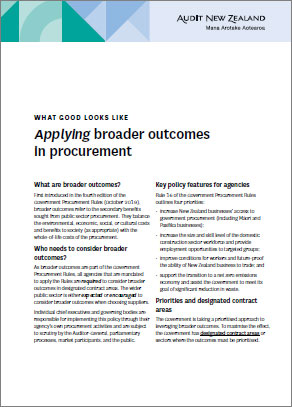What good looks like: Applying broader outcomes in procurement
This is part of our series on What good looks like, produced by our Specialist Audit and Assurance Services team.
![]() Download PDF of Applying broader outcomes in procurement, 67KB, 2 pages
Download PDF of Applying broader outcomes in procurement, 67KB, 2 pages
 What are broader outcomes?
What are broader outcomes?
First introduced in the fourth edition of the Government Procurement Rules (October 2019), broader outcomes refer to the secondary benefits sought from public sector procurement. They balance the environmental, economic, social, or cultural costs and benefits to society (as appropriate) with the whole-of-life costs of the procurement.
Who needs to consider broader outcomes?
As broader outcomes are part of the Government Procurement Rules, all agencies that are mandated to apply the Rules are required to consider broader outcomes in designated contract areas. The wider public sector is either expected or encouraged to consider broader outcomes when choosing suppliers.
Individual chief executives and governing bodies are responsible for implementing this policy through their agency’s own procurement activities and are subject to scrutiny by the Auditor-General, parliamentary processes, market participants, and the public.
Key policy features for agencies
Rule 16 of the Government Procurement Rules outlines four priorities:
- increase New Zealand businesses’ access to government procurement (including Māori and Pasifika businesses);
- increase the size and skill level of the domestic construction sector workforce and provide employment opportunities to targeted groups;
- improve conditions for workers and future-proof the ability of New Zealand business to trade; and
- support the transition to a net zero emissions economy and assist the Government to meet its goal of significant reduction in waste.
Priorities and designated contract areas
The Government is taking a prioritised approach to leveraging broader outcomes. To maximise the effect, the Government has designated contract areas or sectors where the outcomes must be prioritised.
| Outcome | Designated contract area |
|---|---|
| Priority outcome one: Increasing access for New Zealand businesses | ICT services/computer software |
| Priority outcome two: Construction skills and training | Construction |
| Priority outcome three: Employment standards | Cleaning services, security services, and forestry contracts |
| Priority outcome three: Health and safety | All contracts with a particular focus on forestry contracts and construction contracts |
| Priority outcome four: Reducing emissions | Light vehicles |
| Priority outcome four: Reducing emissions | Stationary/process heating systems |
| Priority outcome four: Reducing waste | Office supplies |
We expect mandated agencies to have:
- an up-to-date procurement policy on leveraging broader outcomes;
- a clear approach to the way broader outcomes are:
- considered in procurement planning;
- included in tender documents and selection criteria; and
- assessed, measured, and monitored;
- information on current contracts and suppliers that can identify those related to the designated contract areas; and
- specific procurement approaches for new contracts in designated areas that explicitly factor in delivery of broader outcomes.
Agencies should ask themselves …
- Have we reviewed our procurement policies, procedures, tools, and templates to address broader outcomes?
- Are we applying our procurement policies consistently and well?
- Do senior managers and governors have the information they need to monitor and review the agency’s support of broader outcomes?
- Do we have a framework to monitor progress and further review our approach if needed?
- Do we share what we have learned with our staff and other agencies?
Where to find out more
Audit New Zealand’s website includes a focus on procurement in our What goods looks like series.
Further details can be found at the Ministry of Business, Innovation and Employment’s website about broader outcomes, designated contract areas, and the Government Procurement Rules 16, 17, 18, 19, and 20 that relate to broader outcomes.
